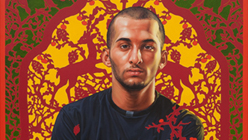Kehinde Wiley is perhaps the most successful American painter of this generation. His hyperrealist portraits largely focus on black and brown men, painted against elaborate decorative motifs sampled from history. Just in his mid-thirties, he is also a prime example of an enterprising international artist with working studios and assistants in New York and Beijing, with perhaps more to come. His paintings regularly sell for hundreds of thousands of dollars and he is intensely prolific. His success is due in part to the broad appeal of his images, which mix historically influenced painting with images of contemporary figures. Some of the most popular have been exquisite portraits of Hip Hop moguls depicted as modern royalty. He has also created an ongoing series of everyday people from different locales around the world. This month the Contemporary Jewish Museum presents Kehinde Wiley | The World Stage: Israel, a series of seductive portraits of Israeli Jews, Ethiopian Jews, and Israeli Arabs tapped from the streets of Jerusalem, Tel Aviv, and Lod.
Figures are depicted seated or standing, in various poses that reference classical paintings. The viewer’s eye struggles to choose focus between spectacularly dense background patterns that creep to the fore and the glowing complexions of Wiley’s subjects. The frames that encase the paintings at the Contemporary Jewish Museum demonstrate profoundly beautiful craftwork, realized with machine-like precision and encoded with symbolism from the black diaspora. There are numerous works in the show, all dated 2011, representing a mere sampling of the artist’s recent production.
Wiley speaks about his work with nimble facility and references classical art while conversationally traversing global cultural histories. Few artists articulate their ideas as clearly as he does. Street casting, as he calls it, is the process by which he navigates a city to consider potential subjects among strangers. His subjects tend to have a certain physical presence. They are all young, between 19 and 35 years old, as he will tell you, and appealing in their self-confidence. The most common trait among them is the force of their gaze. Up close one might admire the detail of decorative elements in each painting, but an ideal encounter with Wiley’s work plays out like a rare moment of connection, when we make eye contact in a crowd. If the work can be said to have an ideal viewing distance, it would be across the space across a street bazaar.

Kehinde Wiley, Mahmud Abu Razak (The World Stage: Israel), 2011. Courtesy of the artist and Roberts & Tilton.
The images confound presupposed ideas about who belongs in historicized portraiture, indeed about who belongs in a museum — or for that matter, with this exhibition, who belongs in which museum. And yet, stereotypes arise within Wiley’s critique of stereotypes: his subjects are typically young, attractive, and able bodied. There is little variation in terms of personal style: no traditional garb, say, or suits. The subjects are consistently depicted in casual street clothes, often jeans and t-shirts emblazoned with sports logos. There are few indications of cultural specificity; if anything much of the clothing looks American. The predominance of Western fashion raises questions that seem separate from the work, at least initially — and pondering an absence of diversity in work that challenges the absence of diversity in the Western art historical cannon is a little mind-bending.



